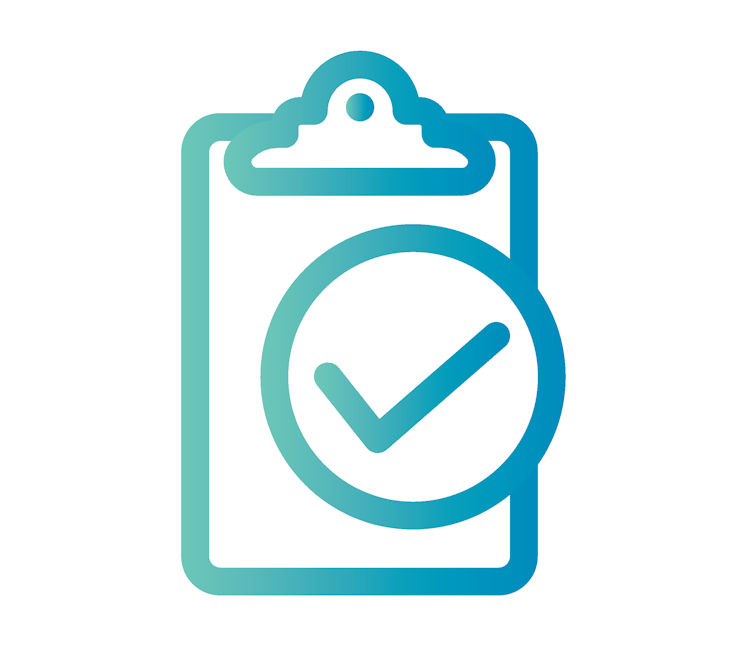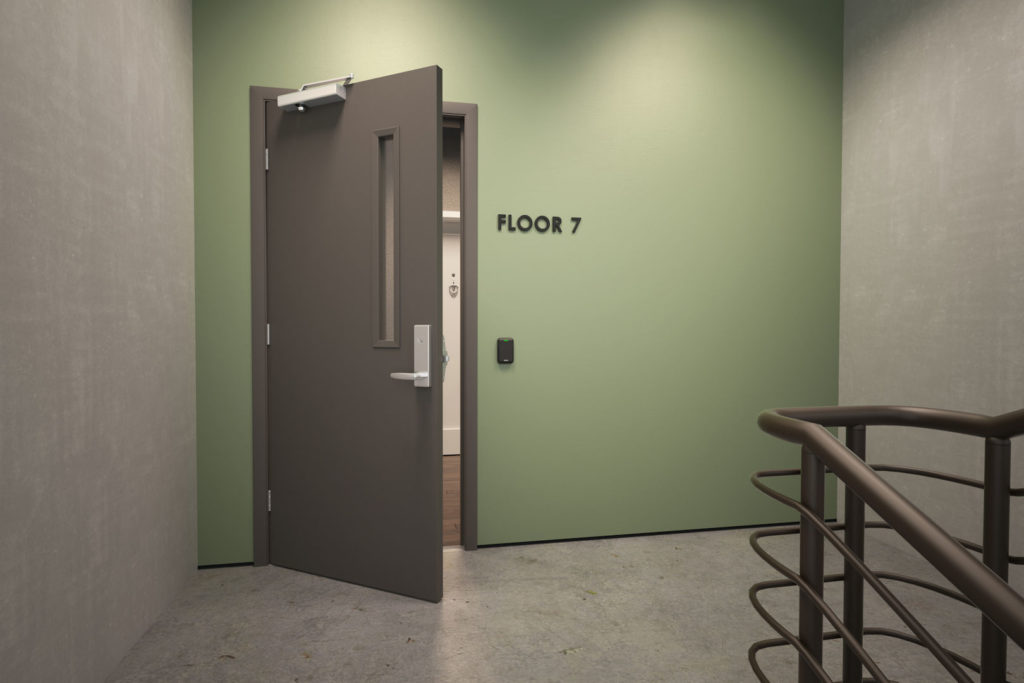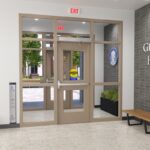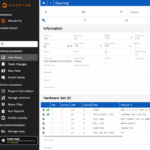This post was updated in March of 2021 – originally published in the December 2018 issue of Door Security + Safety
.

Where are fire door assembly inspections required by code?
The answer: Fire door inspections are required by code in almost every US state. With that said, having something required by code and having those requirements enforced by the Authorities Having Jurisdiction (AHJ) are sometimes two different things.
More than ten years ago, a modification was made to the 2007 edition of NFPA 80 – Standard for Fire Doors and Other Opening Protectives. This new section mandated an annual inspection for each fire door assembly, as part of the ongoing maintenance of the building. The reason for this change was that a very high percentage of existing fire door assemblies were not code-compliant, and they would not provide the protection during a fire that they were designed and tested to ensure.
Although building owners and facility managers have always been responsible for maintaining fire doors properly – replacing broken hardware, preventing modifications, ensuring that non-compliant components were not added – problems with fire door assemblies are often overlooked. When adding requirements for annual inspections conducted by qualified personnel, and mandating that deficiencies found during the inspections must be repaired “without delay,” the goal was to improve the condition and performance of the millions of existing fire doors and increase safety for building occupants.
Roadblocks
When the 2007 edition of NFPA 80 was referenced by the model codes, the assumption was that fire marshals and other AHJs would review the documentation for fire doors during the periodic inspections of buildings in their jurisdictions. The requirements for fire door assembly inspections have now been included in 5 editions of NFPA 80, and those editions have been referenced by the model codes in the 2009, 2012, 2015, 2018, and 2021 editions. But enforcement is still inconsistent.
The introduction of the inspection requirements caused some confusion which contributed to the slow adoption. Some fire marshals thought that they were required to perform the detailed fire door inspections, and they did not have the necessary manpower. In reality, the intent is for the AHJs to ask for and review the documentation – just as they would review the inspection reports for sprinkler systems, stove hoods, or fire extinguishers. In some jurisdictions, buildings are not inspected periodically, or different types of facilities are inspected by different AHJs; this lack of continuity led to inconsistent enforcement. And because the requirements were contained in a referenced standard rather than directly in the model codes, many AHJs were not aware of the change.
The difficulty in getting the word out and increasing enforcement has been frustrating; fire-related injuries and fatalities have occurred that may have been avoided if existing fire doors had provided the intended level of protection. If a door closer on a fire door assembly is broken or missing, and that door does not close to protect the opening in the fire barrier, there’s nothing to deter the spread of smoke and flames through the opening. If that fire door is inspected and the faulty closer repaired or replaced, the closed door will help protect the building occupants.
Moving Forward
This lack of awareness and the resulting spotty enforcement is beginning to change. A fire marshal recently told me that he was excited that his state was finally adopting a fire code that referenced an edition of NFPA 80 mandating annual fire door inspections. He saw the requirement as a tool to help improve life safety, and their department was prepared to start educating their jurisdiction and enforcing the inspection requirements immediately. The adoption of the 2012 edition of NFPA 101 – Life Safety Code by the Centers for Medicare and Medicaid Services (CMS) has also helped to raise awareness. The thousands of health care facilities that receive CMS funding and are subject to periodic surveys by the Joint Commission or another accrediting organization are all required to document their annual fire door inspections, regardless of where the facilities are located.
One challenge has been connecting the dots to establish where the inspection requirements are referenced in the adopted codes and standards. In addition to the fire door requirements of NFPA 80, some smoke doors must also be inspected in accordance with NFPA 105 – Standard for Smoke Door Assemblies and Other Opening Protectives. Below are the paragraph references from each of the current model codes commonly used in the US. Similar references to NFPA 80 and NFPA 105 can be found in past editions of these codes as well.
- NFPA 101 – Life Safety Code: NFPA 101 has been adopted in many jurisdictions as the code addressing provisions for the means of egress. The requirements for fire door assembly inspection are clearly stated in NFPA 101:
- 8.3.3.3.1 Required fire door assemblies shall be installed, inspected, tested, and maintained in accordance with NFPA 80. [NFPA 101 – 2021, 2018]
- 8.2.2.4 Where door assemblies are required elsewhere in this Code to be smoke-leakage-rated in accordance with 8.2.2.4…(3) Door assemblies shall be installed and maintained in accordance with NFPA 105, Standard for Smoke Door Assemblies and Other Opening Protectives. [NFPA 101 – 2021, 2018]
- International Fire Code (IFC) – Many US states have adopted the IFC as their state fire code, with or without state modifications. The requirements for fire doors and smoke doors to be maintained in accordance with the standards includes the requirements for documented inspections:
- 705.2 Inspection and maintenance. Opening protectives in fire-resistance-rated assemblies shall be inspected and maintained in accordance with NFPA 80. Opening protectives in smoke barriers shall be inspected and maintained in accordance with NFPA 80 and NFPA 105. Openings in smoke partitions shall be inspected and maintained in accordance with NFPA 105. [IFC – 2021, 2018]
- International Building Code (IBC) – The IBC is the most widely-used building code in the US and has also been adopted in other countries. The building code is generally used during design and construction, and not referenced for maintenance throughout the life of the building (the adopted fire code is used for that). However, when the building code references NFPA 80 – the 2013 edition or later – these recent editions require fire door assemblies to be inspected after installation, and after maintenance work is completed, in addition to the annual inspections required by the fire code:
- 716.1 General. Opening protectives required by other sections of this code shall comply with the provisions of this section and shall be installed in accordance with NFPA 80. [IBC – 2021, 2018]
- 716.2.10 Installation of door assemblies in corridors and smoke barriers. Installation of smoke doors shall be in accordance with NFPA 105. [IBC – 2021, 2018]
Clearly, the model codes require fire doors and smoke doors to comply with NFPA 80 and NFPA 105. The annual inspections of fire door assemblies began with the 2007 edition of NFPA 80, and the inspections after installation or maintenance work began with the 2013 edition. When the adopted codes in a state or jurisdiction reference an edition of these standards that requires documented fire door inspections, the AHJ can – and should – enforce the requirements unless they are specifically exempted by the state or local code. Detailed information including inspection criteria, documentation, and inspector qualifications are found in NFPA 80 and NFPA 105 – Chapter 5 covers inspection, testing, and maintenance. For more information, consult these publications or visit www.iDigHardware.com/firedoor.
You need to login or register to bookmark/favorite this content.







Lori,
A few questions about the article?
Who is typically performing the fire door inspections? Is it independent companies, building inspectors? Are you seeing door/hardware distributors getting involved in this?
What are the qualifications for being a fire door inspector and who enforces this or provides the credentials?
Who is responsible for enforcing the annual inspections? Are building owners supposed to do this on their own each year? Is the AHJ supposed to notify building owners?
Are building owners given warning for impending inspections? Here in the RTP area, there are numerous pharmaceutical companies and data centers that are very high security. You have to give your first born child as collateral before they’ll let you in the building. How is that handled when they often require drug screening, background checks, etc. (yes, even if you’re only going to be there for 15 mins).
Hi Eric –
I have seen lots of different people/companies offering fire door inspections…locksmiths, distributors, independent inspectors including companies that also do damper inspections. Some end users use their own personnel.
A certification is not required, but the person doing the inspections must be “qualified,” which is defined by NFPA 80 as: “A person who, by possession of a recognized degree, certificate, professional standing, or skill, and who, by knowledge, training, and experience, has demonstrated the ability to deal with the subject matter, the work, or the project.”
There is a good training program available through DHI: https://www.dhi.org/DHI/Education/Fire-and-Egress-Door-Assembly-Inspection-Program/DHI/Education/FDAI-Program.aspx?hkey=f6d1064f-1d63-4641-964f-6c286b014a6b. There are a few others but I don’t have first-hand experience with them. With that said, according to the Joint Commission, they don’t require a certification: https://idighardware.com/2017/04/qq-does-the-joint-commission-require-fire-door-inspectors-to-be-certified/.
The AHJ doesn’t have to notify building owners, but it would obviously be helpful for them to have a heads-up. I highly doubt that a typical building owner would be aware of the change. The inspections are supposed to be enforced by the AHJ, but that could be various people – the fire marshal, the Joint Commission, etc.
The inspection procedures (general inspections, not fire door inspections) vary by jurisdiction. In some locations, the fire marshals only inspect certain types of facilities, and it may not happen every year. Technically, the fire door inspections should still be conducted each year, and the AHJ will review the documentation when they arrive for their periodic inspection. The documentation may also be helpful if there is a fire and/or a lawsuit.
This is definitely still evolving, so the next few years should help to establish the protocols as more jurisdictions begin to enforce the requirements. And I expect to see a vast improvement in the condition of existing fire door assemblies and the general awareness of fire doors, which was the reason behind adding the requirements to NFPA 80.
– Lori
I just had my first AHJ inspector ask the building favilities director for their Fire Door Inspection Log before they would grant them a CO!
They called me to ask what that was?
Houston, Texas
Hi Michael –
I’ve heard from several people in the Houston area that fire door inspections are being enforced there. Have you seen any documentation from the fire marshal? Maybe a letter notifying building owners that the fire marshal will be looking for this documentation?
– Lori
Are inspections required at a new installation. I have a new job that has this in the specifications ” Inspection of fire door assemblies and means-of-egress panic-hardware doors: Per 2016 NFPA-80 5.2.1: hire an independent third-party inspection service to prepare a report listing these doors, and include a statement that there are zero deficiencies with the fire-rated assemblies and the openings with panic hardware.
1. Per 2016 NFPA-80 5.2.1: Use a third party inspector not associated with the construction, supply or installation of this project to develop a field survey of the doors and hardware. Survey is to be done by a member certified as a FDAI (Fire Door Assembly Inspector), Certified AHC (Architectural Hardware Consultant) or a certified testing laboratory: UL or Intertek. Certified Inspectors may be found at DHI.org, Intertek, or CAFDI.org.”
It seems that there is a desire for a inspection from a FDAI before the building is complete. I had thought that this inspection is required after the building is complete and being used and after a period of time (as a maintenance procedure) a inspection was to be preformed. Am I incorrect?
Hi Nate –
The 2007 and 2010 editions of NFPA 80 require fire door inspections annually. Beginning with the 2013 edition, fire door inspections are required after installation and after maintenance work, in addition to annually.
– Lori
How about the smoke doors inspection requirement ? are the requirement the same as the fire doors ? if so which edition of NFPA 105 requires that smoke doors be inspected annually? Thank you Lori
Hi Sid –
The 2013 edition of NFPA 105 says: 5.2.1.1 Smoke door assemblies shall be inspected and tested in accordance with Chapter 5 of NFPA 80, Standard for Fire Doors and Other Opening Protectives. The 2016 edition has duplicated the same requirements that are in 80.
This would apply to doors that are required to comply with NFPA 105 – not all doors that are commonly called “smoke doors” are required to comply with 105.
– Lori
Thanks a lot Lori.
So what are the doors commonly called “smoke doors” ? In my understanding S in the label was enough.
That’s the problem – there are quite a few different types of doors that are commonly called smoke doors. I think I addressed all of them in this article: https://idighardware.com/2015/11/decoded-smoke-door-requirements-of-the-2015-international-building-code/.
– Lori
It’s good to know that fire door inspections are required in most US states. My brother is interested in developing a large commercial building near the highway. I’ll share this info so he can see why it’s important to meet regulations for the building’s fire doors.
I’m 2010 edition are fuseable links required on both sides of the firewall
THE AHJ’s need to enforce ( gently) the State fire code… PERIOD!
It only takes 8 words for an AHJ to increase Fire safety in their Community and achieve better code compliance – at Truly no cost to the department – in the form of personal or budget. .. During their ( hopefully annual) FPP Visit -just say These words- MAY I SEE YOUR FIRE DOOR INSPECTION REPORT !
I don’t know what it’s going to take to get the attention of the AHJ’s to Enforce the code- maybe a major Fire in an apartment building such as happened in the Bronx that killed 17 people -the cause was found to be simply the fact that two fire doors didn’t close properly allowing smoke and fumes to kill and injure all those people.
Why wait to a tragedy occurs the inspections are designed to prevent this and all you need is those eight words.
Dan Arce , ceo . NATIONAL FIREDOOR, llc
I’m with you 100%, Dan!
– Lori